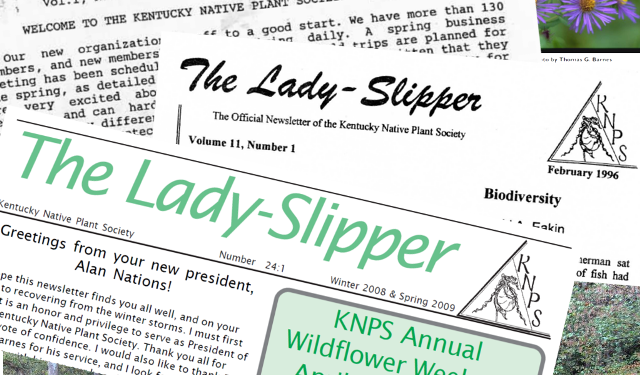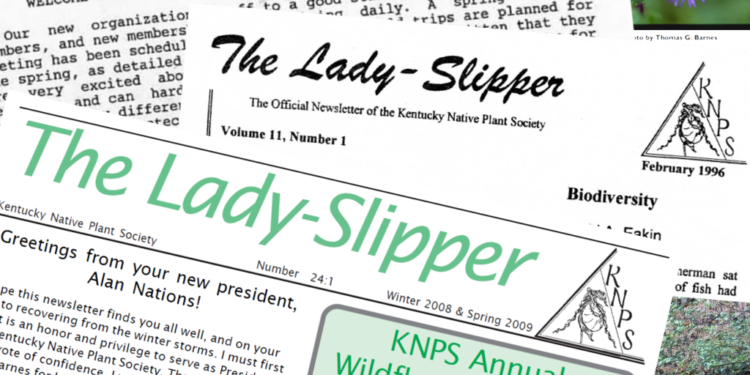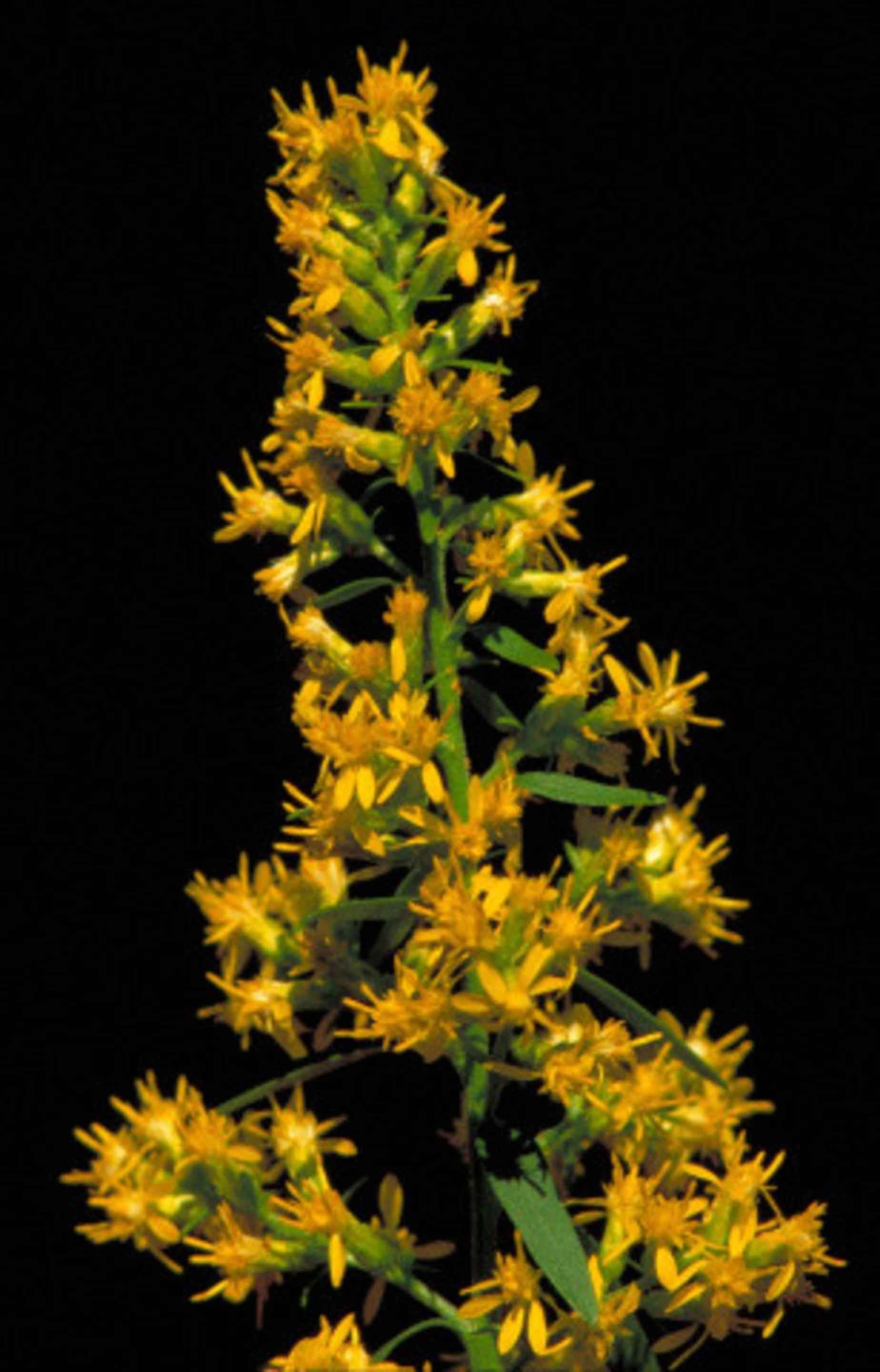The Lady Slipper newsletter of the Kentucky Native Plant Society has been published since the Society’s founding in 1986. We occasionally feature an article from a past issue. This one, about the globally rare, and endangered, Short’s Goldenrod, Solidago shortii, first appeared in the summer of 1999, Vol. 14, No. 2 & 3. If you would like to see other past issues, visit the Lady Slipper Archives, where all issues from Vol. 1, No. 1, February 1986 to Vol. 34, No. 1, Winter/Spring 2019 (after which we moved to this blog format) can be found.
If you would like to see this rare and beautiful goldenrod, plan now to attend the KNPS Fall Meeting on Oct. 15.
A Short Take on Short’s Goldenrod
by James Beck

Anyone out for an afternoon walk or Sunday drive in Kentucky during late August through mid October just can’t miss the bright yellows in every field and fencerow that belong to the Goldenrods (Solidago sp.). Mary Wharton considered 32 different species in the Commonwealth. Two of them, the White Haired Goldenrod and Short’s Goldenrod, are endemic in Kentucky. They are known only from our state. [Editor’s note: at the time this article was written, Short’s goldenrod was only known from Kentucky. Since then a small population has been discovered across the Ohio in at least one county in Indiana.] The White Haired Goldenrod (Solidago albopilosa), discovered by E.L. Braun in the limestone clifflines of what is now Red River Gorge, is known from 90 populations and is listed as Federally Threatened by the US Fish and Wildlife Service. Short’s Goldenrod, (Solidago shortii), listed as Federally Endangered in 1985, is both a beautiful plant, and one with a fascinating history.
This species was first collected by the eminent Dr. C.W. Short (then chair of the Medical Department at the University of Louisville) on Rock Island, which lies at the famous “Falls of the Ohio” between Louisville and Clarksville, Indiana. This is one of several islands and stony outcrops which were dry for part of the year and completely submerged for the remainder, representing the only serious navigational impediment on the Ohio River from Pittsburgh to New Orleans. Sent east for identification, the Goldenrod found at the Falls was subsequently described as a new species by Drs. John Torrey and Asa Gray, then hard at work on the landmark Flora of North America.

Civil engineering projects, culminating with the opening of a hydroelectric dam in 1930, have been historically blamed for the apparent disappearance and extinction of Short’s Goldenrod by the 1870s. It wasn’t until 1939 that the only other known population was discovered by Lucy Braun on rocky slopes and grazed pastures near Blue Licks Battlefield State Park at the convergence of Robertson, Nicholas, and Fleming Counties, Kentucky. Today 13 small subpopulations survive, all within the vicinity of Blue Licks.
The disappearance of this species at the Falls of the Ohio (which may have actually occurred some years before construction of the dam at Louisville) and its decline over the years at Blue Licks have always raised questions. Evidence exists that might support a connection between historic bison usage and S. shortii. Bison were possibly a seed dispersal mechanism, or perhaps Short’s Goldenrod benefited from the reduced plant competition that resulted from their trampling. The Falls of the Ohio represents the most logical crossing point of the Ohio River on a trail which led the bison from the Midwest to the springs and salt licks of central Kentucky. Blue Licks itself is a famous lick, one which lies on a well documented horseshoe-shaped bison trace which began at what is now Covington and made a large circuit through the region, meeting the Ohio again at present day Maysville.

Short’s Goldenrod is easily identified in the field. Totally smooth, leathery leaves and the length of its involucre (the circle of bracts or leaflet-like structures surrounding each flower) separate it out from most of the other local Goldenrod species. The Riverbank Goldenrod, (Solidago rupestris) is the most similar in form, although simple habitat differences (riverbanks versus dry, glady conditions) should end any confusion. Three other Goldenrods, S. altissima, S. ulmifolia, and S. nemoralis, grow with S. shortii at Blue Licks, but sufficient morphological differences exist between them and Short’s, and anyone with a little patience and basic knowledge of terminology should have little trouble finding it.
Short’s Goldenrod is not included in Wharton and Barbour’s Kentucky wildflower guide. The best key to it is the key to Solidago in Gleason and Cronquist’s Manual of the Vascular Plants of Northeastern United States and Adjacent Canada.
The easiest viewing of this rare species occurs in the Kentucky State Nature Preserve Commission’s Buffalo Trace Preserve, which is in the vicinity of Blue Licks Battlefield State Park. A truly unique and enjoyable day trip for any Kentuckian would be traveling from Lexington though Paris and on to the Park, all on US Highway 68. In just a few hours one could enjoy the majesty of the Bluegrass horse farms and the beauty of probably the rarest variety of our state flower.















